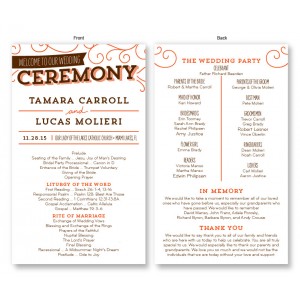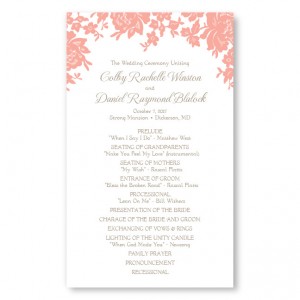With the many obligations that come with planning a wedding, it’s easy to get bogged down and leave details like the wedding program to the bottom of the list. However, if you’re interested in creating a memorable ambiance for your special day, the wedding program is a great way to convey the aesthetic to your guests from the moment they arrive.
It can be elegant, funny, romantic, or quirky. The wedding program serves as a souvenir for you and all your guests for years to come. Follow these steps to make sure this small but important detail sets the intention for your special day.

When Should You Start Planning Your Wedding Program?
There are a lot of elements to consider when it comes to the wedding stationery, and giving yourself enough time to plan will make things easier. Ordering two months ahead of your big day should give you plenty of time.
Before you order, take some time to consider the aesthetic of your wedding ceremony; you’ll want to make sure to incorporate any theme you may have decided on into your wedding program. It might be helpful to put together a wedding mood board to reference during all your wedding preparations.
A mood board is a combination of texts, textures, fonts, and images you feel would best work together to convey a mood. It’s easiest to make one digitally, but it may feel more tangible and exciting to work with a physical version.
Best of all, you often make surprising discoveries about what sorts of elements work well together. Putting together a mood board is like solving a puzzle. Having some ideas of the visual elements you prefer will help guide you when putting together a wedding program.
Elements to Consider
Tone. The tone is important to consider first. What is the mood you are trying to set on your wedding day? If you are striving for elegance, let your program reflect that with muted colors and classic typefaces. If you want a fun wedding, let your sense of humor shine through with quirky handwritten text or drawings. If your wedding is small and intimate, you can personalize the text, so your guests will feel an instant connection.
Text. A traditional wedding program will state the names of the bride, groom and the wedding party, and it outlines the order of the ceremony. This may be all you need, but with some folding templates, you may have more space to get creative.
You may wish to include translations for non-English speaking guests, write additional thank-you messages, or include an anecdote to make the program more personal. The guests will be holding the programs for the entire ceremony, so any extra paper space is valuable real estate.

Typography. A more traditional wedding program may combine script fonts with serifs, where a more contemporary version might include handwritten text. It all depends on the mood you want to create. Scripts and serifs create a timeless look, while handwritten text may feel more intimate and familiar. There are a million possibilities and, if you are interested in personalizing the typography, it’s worth taking some time to familiarize yourself with the basics of typography.
Decorations. A wedding program that’s all text and no image? You don’t need to be a graphic designer to guess that the decorative motifs make a huge difference. If you’ve created a wedding mood board, it will certainly come in handy when deciding how to adorn your wedding program.
If you are looking for a simpler, classic design, a minimalist border in a solid color could be enough. However, if there is a theme to your wedding—and this could vary from floral motifs to wood grain patterns to Christmas lights—the wedding program is the ideal spot to put this theme on display.

Paper. In the digital age, we look at just about everything on a screen, and it’s easy to forget about paper stock. However, the paper makes a huge difference! Ink sits on the surface of glossy paper, so you’ll get a more photo-like finish; conversely, it soaks into a matte paper, which results in a more illustrative look.
Cold press paper is rougher, which can add a rustic quality to your wedding program, while hot press paper is smooth and more familiar. A heavier paper stock will feel more upscale and may make a better souvenir in the long term.
Price. Weddings are expensive, so you’ll want to check the pricing before you commit to purchasing any wedding stationery. If you’re the creative type, you can save a bit of money by doing it yourself.
Final Thoughts
Essentially, the most important part of wedding planning is knowing your aesthetic. If you put together your mood board and stick to your chosen elements, you’re sure to have a beautiful and thoughtfully planned wedding. While you’re at it, make sure to have fun designing. Your wedding is all about you!



